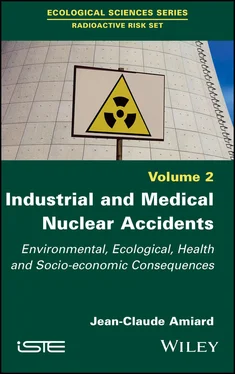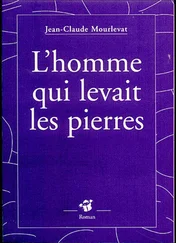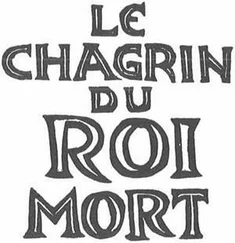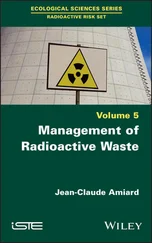Events that occurred before the INES was created were rated retrospectively. In the end, and without being exhaustive, we can note that only two accidents received a rating of 7 (major accident). These are the accidents at Chernobyl (Ukraine) on April 26, 1986 and Fukushima (Japan) on March 11, 2011. One accident was classified as a level 6 accident (serious accident), the Kyshtym disaster in the USSR (Mayak nuclear complex) in 1957. Four events were considered to be level 5 (accident). These were the accident at the Chalk River Laboratories in Canada in 1952, the fire at Windscale (now Sellafield) in the United Kingdom in 1957, the Three Mile Island nuclear accident in the United States in 1979 and the Goiânia nuclear accident in Brazil in 1987 (Table 1.4). This table lists the 10 accidents considered to be the most serious.
1.2.1. Application of the INES in France
The INES was adopted in France by the Autorité de Sûreté Nucléaire (ASN) in April 1994. The application of the scale concerned all the basic nuclear installations controlled by the ASN (EDF reactors, Areva plants, CEA laboratories, etc.).
The feedback from these industries is based on incidents considered significant, i.e. events that could, in unfavorable circumstances, have combined with others to generate major accidents. In order not to be overwhelmed by the number of events to be recorded and analyzed, the French nuclear manufacturers (EDF, CEA, Orano (previously Areva), etc.) decided to distinguish two groups of events of different severity that are relevant to safety and to apply different methods to them. These two groups are événements intéressants la sûreté (events of interest for safety – EIS) and incidents significatifs pour la sûreté (significant safety incidents – ISS) [LEC 04].
EIS are entered into a national computerized file managed by EDF, called the fichier des événements , “event file”. ISS must be notified to safety organizations and be the subject of a detailed analysis report according to a standard plan. This method should facilitate feedback through broad criteria for recording data in databases.
In addition, proactive security methods have been established. This approach to safety has led to technical advances by producing energy more efficiently (fewer cut-offs, shutdowns, reductions of installed capacity) while making financial gains. As in aviation, relevant information is taken into account while ensuring confidentiality and protection for particularly sensitive industrial information [LEC 04].
1.2.2. Application of the INES at the international level
At the international level, three reporting systems are mainly used, namely SOL, IRS and HPIP [LEC 04]. The SOL (Safety through Organizational Learning) system was developed by the Centre for Systems Security Research at the University of Berlin in collaboration with the media outlet TÜV Rheinlandest. It was an approach to event analysis based on the concepts of socio-technical systems and psychological theories of incident genesis (accidents and near accidents). The HPIP (Human Performance Investigation Process) is used by the CRN ( Commission de Régulation Nucléaire ) to investigate events related to human performance in nuclear power plants. Developed by Paradies et al . [PAR 93], the HPIP structure contains six main human failure modules. The IRS (Incident Reporting System) is used by the IAEA and the NEA (OECD Nuclear Energy Agency), developed by the WANO (World Association of Nuclear Operators).
1.2.3. Other classifications of nuclear accidents
The IAEA’s INES classification, while making great progress, is not always satisfactory, and therefore several proposals exist to classify the severity of nuclear accidents. In particular, the three main classification criteria of the INES cannot be applied to radioprotection, i.e. the protection of individuals against ionizing radiation. Similarly, the INES classification does not take sufficient account of the quantities of radionuclides released into the environment.
1.2.4. The NAMS classification
Smythe [SMY 11] proposed a new quantitative scale of nuclear accident magnitude (NAMS). To do this, he used the event magnitude approach by calculating the magnitude of the accident ( M ) from wider releases of radionuclides ( R ). This radioactivity parameter is normalized in iodine 131 equivalents and expressed in TBq. The magnitude is calculated according to the following equation: M = log (20 R ).
Using this NAMS, the distribution between frequency and amplitude has been observed for 33 quantified events over the past 60 years. It follows a reverse power law, as in the case of earthquakes. However, the NAMS shows four exceptional accidents that have values 2–3 orders of magnitude higher than other accidents. These four accidents are, in decreasing order of severity, Chernobyl (NAMS 8.0), Three Mile Island (NAMS 7.9), Fukushima Daiichi (NAMS 7.5) and Kyshtym (NAMS 7.3). According to Smythe [SMY 11], such catastrophic accidents can occur every 12–15 years.
1.3. Classification of radiological accidents
Croüail and Lefaure [CRO 03a, CRO 03b] proposed a more radiologically realistic scale for classifying incidents and accidents. This scale makes it possible to take into account radiation protection events affecting patients as part of a radiotherapy procedure. This proposed scale was then discussed at the IAEA. English-speaking countries did not want to use a classification based on the number of people exposed. They only partially gave way on this point by downgrading certain events [ASN 04] by one level.
Therefore, since 2007, in France, a specific scale has been created, called the ASN-SFRO scale, which characterizes the severity of radiation protection events. The guide for the application of the new INES for the classification of radiation protection events (excluding patients) relating to radioactive sources and the transport of radioactive materials is currently being developed. Radiotherapy events affecting patients were classified on the ASN-SFRO scale issued by the ASN in July 2008 [ASN 08b, ASN 13]. The criteria for ranking on this scale focus on: (1) the proven consequences of exposure to ionizing radiation; and (2) the potential effects of the events (Table 1.2). Levels 0 and 1 are used to classify events without clinical consequences for the patient. Levels 2 and 3 correspond to events referred to as “incidents”. Levels 4–7 correspond to accidents (Table 1.3).
The IRSN [IRS 16a] provides some examples of incidents, such as the level 1 incident where, on October 31, 2008, a practitioner and two manipulators were contaminated with iodine 131 due to inadequate follow-up of cleaning procedures for objects that came into contact with this radioactive element. For level 2 incidents, the IRSN selected three examples. Following an irradiation zone error during radiotherapy performed on December 4, 2008, a patient was re-irradiated in an area after he had already been treated. According to doctors, his condition is now satisfactory. An overexposure of a patient occurred on December 24, 2008 during external radiotherapy during control exposures before a second treatment stage. According to the medical team, the patient’s condition who is receiving special follow-up is currently satisfactory. On June 15, 2007, when a patient was irradiated, the manipulator was still in the treatment room. Based on the effective dose received (approximately 30 mSv), no health effects were expected for this person.
Table 1.2. The ASN-SFRO classification for radiological accidents (adapted from the ASN [ASN 13]. (1) Common Terminology Criteria for Adverse Event, Cancer Therapy Evaluation Program, August 2006, http://ctep.cancer.gov
Читать дальше












